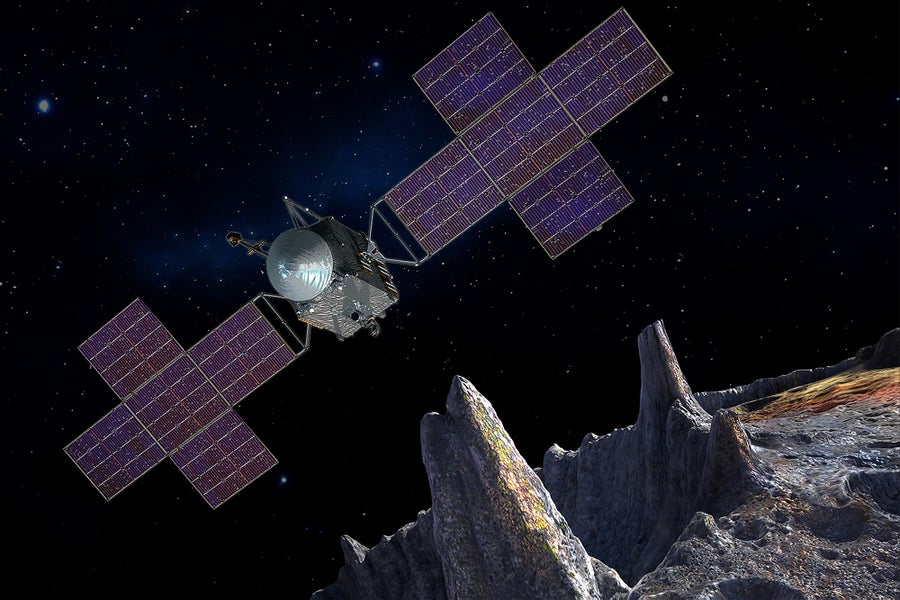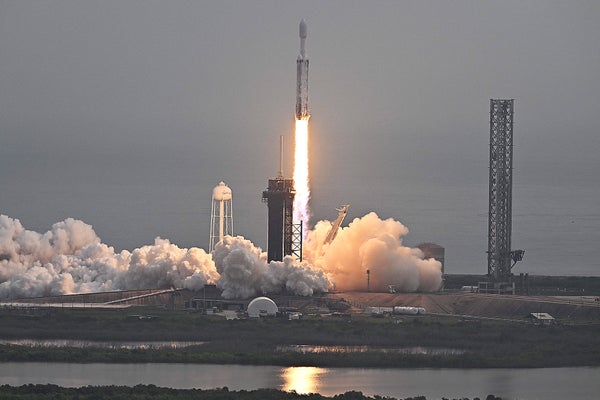Deep in the asteroid belt, between Mars and Jupiter, lies a strange, metal-rich asteroid unlike anything anyone has ever seen before. Dubbed Psyche, the unique object may offer investigators a truly alien landscape to explore—one that could yield new insights about the origin of our solar system and perhaps even about Earth’s most remote region: our planet’s enigmatic, unreachable core.
Now, finally, researchers are one step closer to revealing Psyche’s secrets, thanks to a newly launched NASA mission of the same name. The Psyche spacecraft blasted off on Friday morning atop a SpaceX Falcon Heavy rocket from the agency’s Kennedy Space Center in Florida. With the launch, the craft wrapped up a troubled stay on Earth and began an eight-year mission that is destined to reveal untold surprises about the mysterious metallic space rock. Suffice to say, scientists are psyched about Psyche.
“That’s really a thrill of a lifetime, to sit on console in mission ops and watch your spacecraft launch on the rocket,” says Lindy Elkins-Tanton, a planetary scientist at Arizona State University and the mission’s principal investigator. “The moment after launch, when we’re in communications, the spacecraft is power-positive, and it’s thermally stable—that’s the jumping-up-and-down-screaming moment.”
On supporting science journalism
If you're enjoying this article, consider supporting our award-winning journalism by subscribing. By purchasing a subscription you are helping to ensure the future of impactful stories about the discoveries and ideas shaping our world today.
The Falcon Heavy roared off the launch pad at 10:19 A.M. local time; less than five minutes later, it had ascended through the rough-and-tumble aerodynamics of Earth’s atmosphere, shedding the protective fairings encasing its interplanetary payload. Nearly an hour after launch and a subsequent two-minute burn of the Falcon Heavy’s second-stage engine, Psyche separated from the booster and begin its solitary voyage through space. The spacecraft also sent an initial signal suggesting all was well.*
During the following hour or two, the spacecraft will deploy its two cross-shaped solar-power arrays, orient itself with regards to the sun and establish contact with mission controllers on Earth. These steps mark the start of a 100-day initial checkout period to establish Psyche’s tenure in space.

This artist's-concept illustration depicts the spacecraft of NASA's Psyche mission near the mission's target. Credit: NASA/JPL-Caltech/Maxar/Arizona State Univ./Space Systems Loral/Peter Rubin
The launch marks the first of a trio of key NASA science flights that are reliant on the powerful Falcon Heavy rocket, which debuted in 2018. Falcon Heavy is a three-booster variant of SpaceX’s workhorse Falcon 9 launcher. Next year NASA’s Europa Clipper spacecraft is due to launch onboard a Falcon Heavy on a mission designed to explore Jupiter’s icy and astrobiologically intriguing moon Europa. A Falcon Heavy is also slated to launch the agency’s Nancy Grace Roman Space Telescope in 2027.
Today’s launch ends a challenging beginning on Earth for the Psyche mission. The spacecraft was initially scheduled to depart during a window that opened in August 2022, but months before that appointed time, NASA announced that the mission wouldn’t manage a launch that year because of an issue with the spacecraft’s navigation software. Psyche was forced to undergo an agency-level review that could, in principle, have resulted in the mission’s cancellation.
Instead the review made recommendations that helped put Psyche back on track, although the mission suffered an additional slight delay about a week before its three-week 2023 launch window was due to open when NASA announced that the spacecraft would sit the first week out because of a problem with its nitrogen thrusters. The launch also faced a one-day delay because of bad weather.
But to the mission team’s relief, Psyche now begins a six-year cruise through the solar system out to the asteroid belt, giving the team plenty of time to test the spacecraft instruments and fine-tune the plan for on-site operations. During the first two years of its flight, Psyche will also host the Deep Space Optical Communications experiment, a separate project testing laser communication technology in deep space. A highlight of the cruise will come in 2026 when the spacecraft flies past Mars to boost its speed, turning its instruments toward the Red Planet as it goes. The mission arrives at Psyche in August 2029, where nominal operations are planned for a little more than two Earth years—a little less than half the time it takes the asteroid to complete an orbit around the sun.
Upon arrival, the Psyche spacecraft will set to work. It will use a pair of twin cameras to photograph the surface of the eponymous asteroid, a spectrometer to analyze its chemical composition, a magnetometer to hunt for signs of an ancient magnetic field and a radio communications system to map the object’s gravity—which will allow scientists to remotely probe its hidden subsurface.
Scientists hope the results will solve the biggest mystery about the asteroid Psyche: what it actually is. Right now astronomers are only confident about its orbit, size and shape—as well as the fact that its density and surface are both consistent with a metallic composition that is much richer than that of typical space rocks, such as the ones that NASA’s OSIRIS-REx mission just delivered to Earth.
But that’s about all anyone can confidently say about Psyche—and the mystery is the essence of the mission’s appeal. “So many of the things that we study are part of a population,” Elkins-Tanton says. “We don’t have that for Psyche. There are just not very many objects that are even similar to it, and it’s the only one that’s big, so it’s singular. So it probably came from an unusual process that only created one of it.”
What scientists lack in knowledge about Psyche, they make up for with a host of hypotheses. Of those, mission personnel admit that their favorite is the notion that Psyche formed as the metallic heart of a miniature planetlike body and then lost much of its rocky outer layers to a truly world-shattering collision. If this is indeed Psyche’s story, studying the strange asteroid would offer scientists their first peek at the heavy-metal cores lurking inaccessibly deep inside Earth and other rocky planets.
“We basically have no access to the core of anything,” says Katherine de Kleer, a planetary astronomer at the California Institute of Technology, who is not involved in the Psyche mission. “We can’t observe Earth’s core directly. We can’t observe the core of any other planet directly. Everything is indirect inference.”
Another potential explanation for Psyche’s strangeness holds that the asteroid formed close to the sun, where high temperatures would have allowed metal to solidify and endure while rock remained molten and was somehow stripped away. Some sort of orbital reshuffling—perhaps driven by the gravitational influence of Jupiter and Saturn, which are thought to have thrown their weight around in the early solar system—then must have carried the metallic body out to the asteroid belt.
Or perhaps the mysterious object was created by some other process that is entirely different. In the eyes of mission scientists, there’s no bad answer. “Even if this isn’t the core of an ancient planetesimal, in that new ‘other’ hypothesis, it’s still something really interesting and different and a kind of object we’ve never seen up close before,” says Jim Bell, a planetary scientist at Arizona State University and imaging lead on the Psyche mission. “It’s not like the mission fails if [the asteroid] is not a core. We’re still going to learn something really, really interesting.”
That hoped-for novelty may well manifest as soon as the spacecraft arrives at its otherworldly destination. NASA has only visited rocky and icy worlds before—never a heavy-metal world, where familiar geologic processes may unfold in a very alien way.
One question is whether Psyche ever harbored volcanic activity, with flows of molten metal lava seeping from fissures in the world’s shiny surface. Lab experiments suggest that such flows would form low, braided channels of spectacular intricacy—although scientists can’t yet be certain.
“There are some big caveats to that because those experiments that we did were here on Earth,” says Arianna Soldati, a volcanologist at North Carolina State University, who is not involved in the Psyche mission but took part in research attempting to replicate metallic lava flows on Earth. “It’s unclear what that would look like on Psyche, which has completely different conditions.”
Scientists are more confident that they’ll find impact craters, which could also look different on a metallic world, compared with a rocky surface such as Earth’s impact-battered moon. Lab experiments suggest that Psyche’s craters might be ringed by spiky crowns of metal droplets that froze when they splashed up from the surface—although again, there’s no telling in advance what the spacecraft will reveal.
“It’s so fun to go to a place where we don’t know that much,” Elkins-Tanton says. “We’ve gotten kind of used to going to places where we know [more].”
*Editor’s Note (10/13/23): This paragraph was updated after posting to reflect that the spacecraft successfully separated from the rocket.
